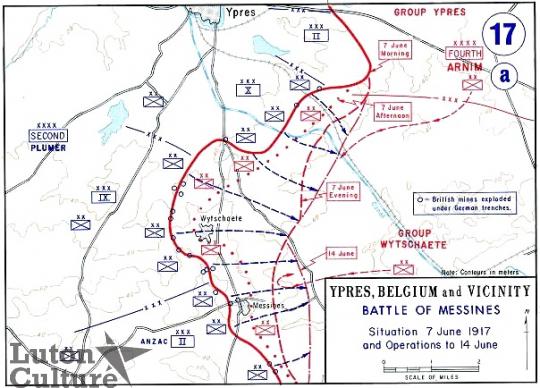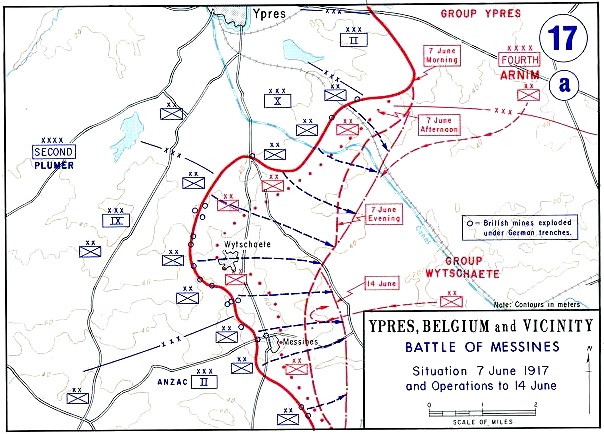The Battle of Messines
Event date
Classifications
Source
Source Date

The Battle of Messines (7–14 June 1917) was an offensive conducted by the British Second Army, under the command of General Herbert Plumer, on the Western Front near the village of Messines in Belgian West Flanders during the First World War. The Nivelle offensive in April and May had failed to achieve its more ambitious aims and this had resulted in the demoralisation of French troops and the dislocation of the Anglo-French strategy for 1917
|
|||||||
| Belligerents | |||||||
|---|---|---|---|---|---|---|---|
 British Empire British Empire
|
 German Empire German Empire
|
||||||
| Commanders and leaders | |||||||
 Douglas Haig Douglas Haig Herbert Plumer Herbert Plumer |
 Crown Prince Rupprecht Crown Prince Rupprecht Sixt von Armin Sixt von Armin |
||||||
| Units involved | |||||||
 Second Army Second Army |
 XIX Corps XIX Corps |
||||||
| Strength | |||||||
| 9 divisions and 3 in reserve: 216,000 men | 5 divisions: 126,000 men | ||||||
| Casualties and losses | |||||||
| 24,562: 1–12 June | 25,000: 21 May – 10 June of whom 10,000 were reported missing, 7,200 being taken prisoner | ||||||
.
The offensive at Messines forced the German Army to move reserves to Flanders from the Arras and Aisne fronts, which relieved pressure on the French Army. The tactical objective of the attack at Messines was to capture the German defences on the ridge, which ran from Ploegsteert ("Plugstreet") Wood in the south through Messines and Wytschaete to Mt. Sorrel, to deprive the German Fourth Army of the high ground south of Ypres. The ridge commanded the British defences and back areas further north, from which the British intended to conduct the "Northern Operation", to advance to Passchendaele Ridge, then capture the Belgian coast up to the Dutch frontier.
The Second Army contained five corps, of which three conducted the attack and two remained on the northern flank, not engaged in the main operation; another corps was available if needed in "General Headquarters reserve" (GHQ reserve). The German Fourth Army divisions of Gruppe Wijtschate ("Group Wytschaete") held the ridge, which were later reinforced by a division from Gruppe Ypern. The battle began with the detonation of 19 mines, which devastated the German front line defences, followed by a creeping barrage 700 yards (640 m) deep, covering the British troops as they secured the ridge with support from tanks, cavalry patrols and aircraft. The effectiveness of the British mines, barrages and bombardments, was improved by advances in artillery survey, flash-spotting and centralised control of artillery operations from the Second Army headquarters. British attacks from 8–14 June advanced the new front line beyond the former German Sehnen (Oosttaverne) line. The Battle of Messines was a prelude to the much larger Third Battle of Ypres campaign, the preliminary bombardment for which began on 11 July 1917.
Event Place
Author: David









Add comment